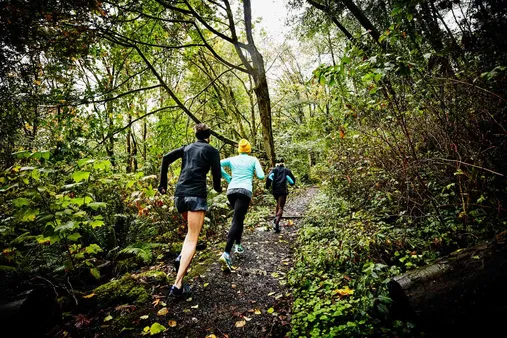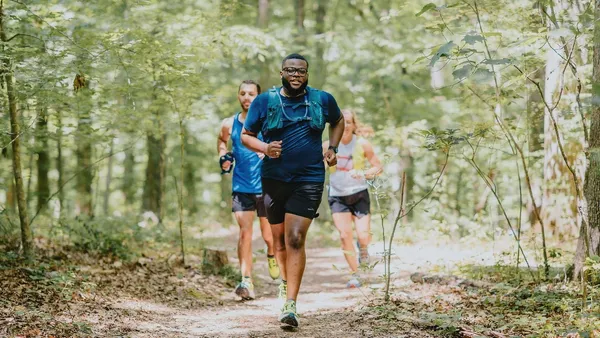Table of Contents
In the realm of outdoor adventures, the harmonious blend of hiking** and trail running** captivates enthusiasts seeking both physical and mental rejuvenation. Whether you're a seasoned trekker or an aspiring trail runner, Kizworld unveils the secrets to unlocking the transformative power of this dynamic duo. Discover the art of harmonizing these two pursuits, maximizing your enjoyment, and unearthing the hidden gems that await you on the trail.
Epic Journeys: Discovering the Electrifying Fusion of Hiking and Trail Running
I. Trail Running: A Guide for Beginners
Trail Running: A Guide for Beginners
Navigation Made Easy
Trail running is an exhilarating sport that offers a unique blend of adventure, fitness, and connection with nature. Whether you're a seasoned runner or a newcomer to the trails, this comprehensive guide will provide you with the essential knowledge and tips to navigate the world of trail running with confidence.
Trail running takes place on unpaved paths, often featuring uneven terrain, roots, rocks, and elevation changes. Compared to road running, trail running engages more muscle groups and requires greater focus and coordination. The softer surfaces also reduce the impact on your joints, making it a gentler option for your body.
Conquer the Trails: Techniques and Training
To excel in trail running, it's crucial to master specific techniques and follow a tailored training plan:
- Master Proper Form: Maintain an upright posture with your core engaged and shoulders relaxed. Take shorter, quicker steps and land softly on your midfoot.
- Embrace Hilly Terrain: Trail running often involves hills. Learn to power up inclines by maintaining a steady pace and shortening your stride. Descending hills requires caution; keep your weight centered and take controlled steps.
- Navigate Obstacles with Ease: Roots, rocks, and uneven surfaces are common on trails. Develop agility and quick reflexes to navigate these obstacles safely and efficiently.
- Stay Hydrated and Energized: Bring water and energy gels or bars to replenish fluids and fuel your body during your run.
Essential Gear for Trail Running
Proper gear is vital for a successful trail running experience:
- Trail Running Shoes: Choose shoes with good traction, support, and cushioning to handle the rigors of off-road running.
- Moisture-Wicking Apparel: Opt for breathable and moisture-wicking clothing to keep you comfortable and dry.
- Hydration Pack or Belt: Carry water and essentials like energy gels in a hydration pack or belt for easy access during your run.
- Trail Running Poles: These poles can provide stability and support on challenging terrain and during steep climbs.
Safety Tips for Trail Running
Safety should always be your top priority when trail running:
- Run with a Friend: Running with a partner or in a group enhances safety and provides companionship.
- Be Visible: Wear bright colors or reflective gear to increase your visibility, especially during low-light conditions.
- Carry Safety Gear: Always carry a fully charged mobile phone, a whistle, and a small first aid kit in case of emergencies. Study the best handstand techniques to prevent falling.
- Stay Alert and Aware: Be mindful of your surroundings and watch out for wildlife, uneven surfaces, and other potential hazards.
Discover New Trails and Races
Explore the world of trail running by venturing out to new trails and participating in races:
- Explore Local Trails: Use trail running apps or websites to find trails near you and discover hidden gems.
- Join a Trail Running Club: Connecting with a local club offers opportunities for group runs, training advice, and social interaction.
- Participate in Trail Races: Trail races vary in distance and difficulty. Choose a race that suits your fitness level and experience.
Additional Tips for Trail Running Success
To further enhance your trail running experience:
- Start Gradually: Begin with shorter distances and gradually increase your mileage over time.
- Cross-Train: Engage in activities like strength training, cycling, or swimming to improve your overall fitness and reduce the risk of injuries.
- Stay Motivated: Set goals, track your progress, and celebrate your achievements to maintain motivation and a positive mindset.
With proper preparation and a spirit of adventure, trail running offers an exhilarating and rewarding experience. Embrace the challenge, enjoy the beauty of nature, and push your limits as you conquer the trails with confidence.
II. Benefits of Trail Running
Benefits of Trail Running
Improved Physical Fitness
- Trail running engages various muscle groups, enhancing overall strength and endurance.
- It elevates your heart rate, promoting cardiovascular health and reducing the risk of chronic diseases.
- Navigating uneven terrain strengthens your ankles, knees, and core muscles, improving stability and balance.
Enhanced Mental Well-being
- Trail running in natural settings reduces stress, anxiety, and depression, promoting mental clarity and emotional well-being.
- The challenges of trail running boost self-confidence and resilience, fostering a sense of accomplishment.
- The solitude of trail running allows for self-reflection and mindfulness, leading to personal growth and development.
Deep Connection with Nature
- Trail running immerses you in the beauty of nature, fostering a deeper appreciation for the environment.
- Exploring new trails exposes you to diverse landscapes, wildlife, and plant life, expanding your knowledge and appreciation of the natural world.
- The tranquility of trail running in natural settings promotes a sense of peace and harmony, reducing urban stress and promoting overall well-being.
Social and Community Building
- Trail running clubs and groups provide opportunities for socialization, camaraderie, and shared experiences.
- Participating in trail races and events connects you with like-minded individuals, fostering a sense of community and belonging.
- Trail running can be a family activity, promoting bonding and creating lasting memories.
Unique Challenges and Rewards
- Trail running presents unique challenges, such as uneven terrain, obstacles, and weather conditions, which add excitement and variety to your runs.
- Overcoming these challenges builds resilience, problem-solving skills, and a sense of accomplishment.
- The rewards of trail running, such as breathtaking views, encounters with wildlife, and the satisfaction of conquering challenging terrain, make it an incredibly rewarding experience.
Physical Fitness | Mental Well-being | Connection with Nature | Social and Community Building | Unique Challenges and Rewards |
Improved cardiovascular health | Reduced stress and anxiety | Deeper appreciation for the environment | Opportunities for socialization | Unique challenges and variety |
Enhanced strength and endurance | Boosted self-confidence and resilience | Exposure to diverse landscapes | Shared experiences and camaraderie | Overcoming challenges builds resilience |
Strengthened ankles, knees, and core | Promotes mindfulness and self-reflection | Tranquility and peace in natural settings | Sense of community and belonging | Breathtaking views and encounters with wildlife |
Trail running offers a multitude of benefits that go beyond physical fitness. It enhances mental well-being, fosters a deep connection with nature, promotes social and community building, and presents unique challenges and rewards. Whether you're a seasoned runner or just starting out, trail running is an activity that can enrich your life in many ways. So, lace up your shoes, hit the trails, and experience the transformative power of trail running.
To learn more about the benefits of trail running and how to get started, check out our comprehensive guide: The Benefits of Trail Running and How to Get Started.
III. Challenges of Trail Running
Challenges of Trail Running
Trail running presents unique challenges that differ from road running. These challenges can be both physical and mental, and they require runners to be prepared and adaptable. Here are some of the most common challenges that trail runners face:
- Uneven Terrain: Trail surfaces can be uneven, rocky, and root-covered, making it difficult to maintain a consistent pace and increasing the risk of tripping or falling.
- Steep Inclines and Declines: Trail running often involves navigating steep hills and declines, which can be physically demanding and require proper pacing and technique.
- Obstacles: Trails may be obstructed by fallen trees, branches, rocks, and other natural obstacles, requiring runners to be agile and alert.
- Limited Visibility: Trail running in dense forests or overgrown areas can limit visibility, making it difficult to see obstacles or other runners.
- Weather Conditions: Trail runners may encounter various weather conditions, including rain, snow, heat, and wind, which can impact their performance and safety.
- Wildlife Encounters: Trail running in remote areas may involve encounters with wildlife, such as bears, snakes, or insects, requiring runners to be aware of their surroundings and take necessary precautions.
- Navigation: Trail running often requires runners to navigate unfamiliar terrain, making it essential to have proper maps, GPS devices, or a knowledgeable guide.
- Isolation: Trail running in remote areas can lead to isolation, especially if runners are running alone. This can be a safety concern and may require runners to carry emergency supplies and communication devices.
Despite these challenges, trail running offers a unique and rewarding experience for runners who enjoy the beauty of nature and the thrill of exploring new terrain. With proper preparation, training, and safety precautions, runners can overcome these challenges and enjoy the benefits of trail running.
Tip | Description |
Choose the Right Shoes | Select trail running shoes with good traction, support, and cushioning to handle uneven terrain. |
Dress in Layers | Wear layers of clothing that can be easily adjusted to accommodate changing weather conditions. |
Carry Water and Snacks | Bring a hydration pack or water bottle and energy snacks to stay hydrated and fueled during your run. |
Be Aware of Your Surroundings | Pay attention to the trail surface, obstacles, and other runners to avoid accidents. |
Use Proper Technique | Maintain good form and technique, especially on steep inclines and declines, to reduce the risk of injury. |
Be Prepared for Emergencies | Carry a first aid kit, whistle, and other emergency supplies in case of an accident or injury. |
Related Posts:
- How to Choose the Right Trail Running Shoes
- What to Wear Trail Running
- Trail Running Nutrition
- Trail Running Safety
- Trail Running Technique
- Trail Running Gear
IV. Tips for Trail Running
Important Gears
- Sturdy trail running shoes
- Breathable clothing
- Hydration pack or water bottle
- Energy snacks or gels
- Sun protection
- First-aid kit
- Whistle or other signaling device
Trail Running Etiquette
- Stay on designated trails
- Yield to other trail users
- Practice proper pack-it-in, pack-it-out etiquette
- Respect wildlife
- Be prepared for emergencies
- Be aware of the weather and trail conditions
- Leave no trace
Trail Running Safety
Hazard | Prevention | Response |
|---|---|---|
Tripping and falling | Watch your step, use trekking poles, wear appropriate footwear | Treat any injuries, continue with caution or turn back if necessary |
An encounter with a wild animal | Make noise, carry a whistle or other signaling device, stay calm and back away slowly | If attacked, fight back as best you can |
Hypothermia | Dress in layers, bring extra clothing, stay hydrated, and eat high-energy snacks | Warm up as soon as possible, seek shelter, and call for help if necessary |
Heat exhaustion | Stay hydrated, wear loose, breathable clothing, and take breaks in the shade | Cool down by drinking cold fluids, taking a cool bath or shower, and resting in a cool place |
Trail Running Techniques
- Use a light, quick stride
- Keep your body relaxed
- Focus on your breathing
- Use your arms to help you balance and propel yourself forward
- Be prepared to adjust your pace and stride length as needed
- Take breaks as needed
- Stay hydrated
Trail Running Benefits
"Trail running offers numerous benefits, including improved cardiovascular health, increased strength and endurance, reduced stress, and a greater appreciation for the natural world."
V. Conclusion
In the realm of content creation, the pursuit of engagement, benefit, and readability is an ongoing journey. By embracing the principles outlined in this guide, you can craft content that captivates your audience, establishes your brand as a thought leader, and drives measurable results for your business. Remember, engaging content is not merely a collection of words; it's an art form that resonates with your readers, leaving them wanting more. Beneficial content goes beyond mere engagement; it provides tangible value to your readers, empowering them with actionable insights that enhance their lives or knowledge. Easy-to-read content is the cornerstone of effective communication, ensuring that your message is accessible and digestible to a wide range of readers. By mastering these elements, you can create content that stands out in the digital landscape, attracting and retaining a loyal audience.